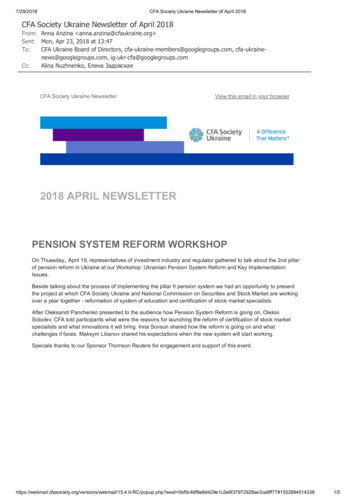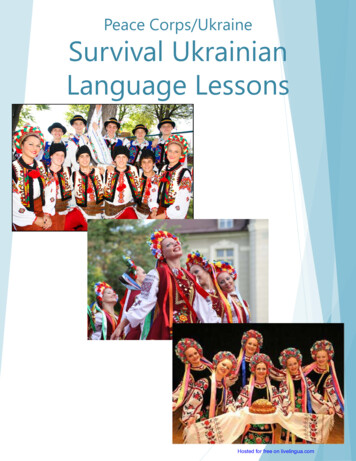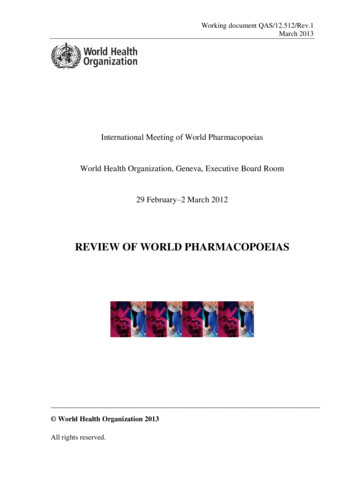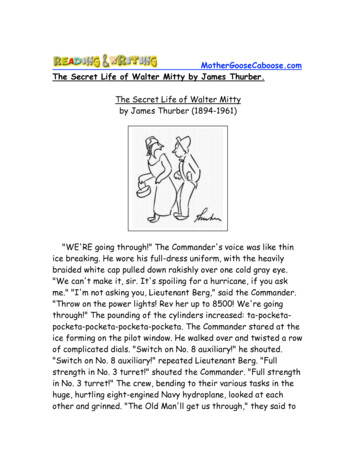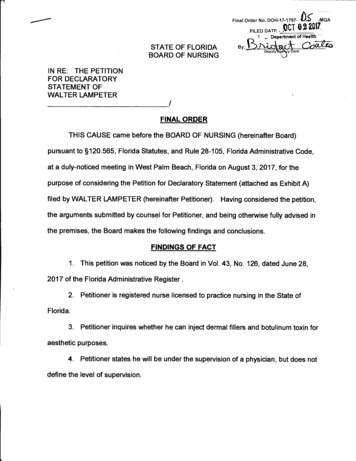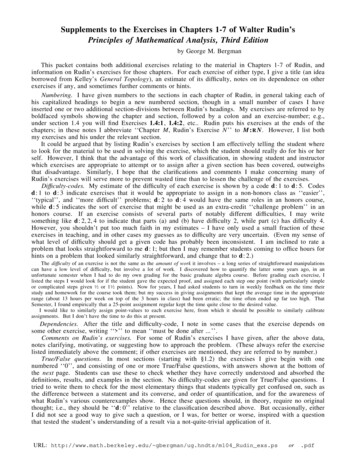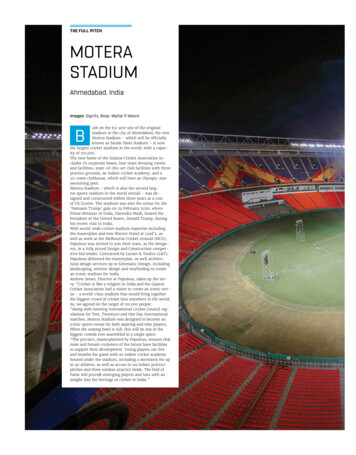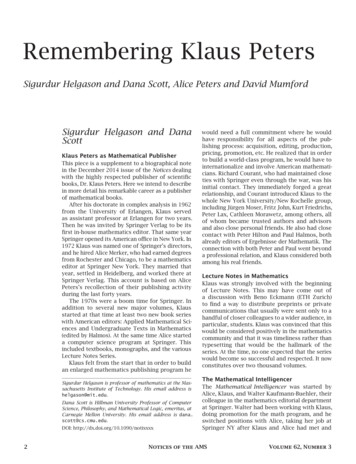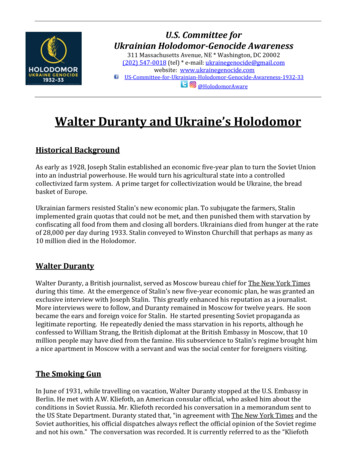
Transcription
U.S. Committee forUkrainian Holodomor-Genocide Awareness311 Massachusetts Avenue, NE * Washington, DC 20002(202) 547-0018 (tel) * e-mail: ukrainegenocide@gmail.comwebsite: eWalter Duranty and Ukraine’s HolodomorHistorical BackgroundAs early as 1928, Joseph Stalin established an economic five-year plan to turn the Soviet Unioninto an industrial powerhouse. He would turn his agricultural state into a controlledcollectivized farm system. A prime target for collectivization would be Ukraine, the breadbasket of Europe.Ukrainian farmers resisted Stalin’s new economic plan. To subjugate the farmers, Stalinimplemented grain quotas that could not be met, and then punished them with starvation byconfiscating all food from them and closing all borders. Ukrainians died from hunger at the rateof 28,000 per day during 1933. Stalin conveyed to Winston Churchill that perhaps as many as10 million died in the Holodomor.Walter DurantyWalter Duranty, a British journalist, served as Moscow bureau chief for The New York Timesduring this time. At the emergence of Stalin’s new five-year economic plan, he was granted anexclusive interview with Joseph Stalin. This greatly enhanced his reputation as a journalist.More interviews were to follow, and Duranty remained in Moscow for twelve years. He soonbecame the ears and foreign voice for Stalin. He started presenting Soviet propaganda aslegitimate reporting. He repeatedly denied the mass starvation in his reports, although heconfessed to William Strang, the British diplomat at the British Embassy in Moscow, that 10million people may have died from the famine. His subservience to Stalin’s regime brought hima nice apartment in Moscow with a servant and was the social center for foreigners visiting.The Smoking GunIn June of 1931, while travelling on vacation, Walter Duranty stopped at the U.S. Embassy inBerlin. He met with A.W. Kliefoth, an American consular official, who asked him about theconditions in Soviet Russia. Mr. Kliefoth recorded his conversation in a memorandum sent tothe US State Department. Duranty stated that, “in agreement with The New York Times and theSoviet authorities, his official dispatches always reflect the official opinion of the Soviet regimeand not his own.” The conversation was recorded. It is currently referred to as the “Kliefoth
Page 2Memorandum.” With his statement, Duranty clearly admitted that he was an instrument ofStalin.As Famine Rages, Walter Duranty Continues with False Reporting.In Ukraine, as the Holodomor, raged on, Duranty continued to feed Stalin’s propagandamachine by suppressing the truth about the famine with multiple articles to The New YorkTimes. On March 31, 1933 he wrote, “there is no actual starvation or deaths from starvationbut there is widespread mortality from diseases due to malnutrition.” On August 24, 1933,Duranty wrote another article where he stated that “any report of a famine in Russia today is anexaggeration or malignant propaganda, since the projected harvest was even better than theprevious year”.World Affairs and Attitudes Towards the HolodomorAlthough most western governments knew of the famine, they did not want to believe it, norspread such devastating news, since their political leanings were toward a positive vision ofCommunism. The soon to be President Franklin D. Roosevelt accepted the distorted truth, aswell, since he was concerned about the depression in the US. By buying grain from Russia andselling Stalin machinery, they both had something to gain. The truth at that time was somethingfew wanted to hear. With war looming, the West, including the United States, was lusting forpotential allies. Duranty’s information proved useful in establishing relations between the USand the U.S.S.R. and was a key factor in Roosevelt’s 1933 decision to grant official recognition tothe Soviet Union. On September 15, 1934, the Soviet Union was invited to join the League ofNations.News of the Famine Reaches Foreign JournalistsMalcolm Muggeridge, a British journalist from the Manchester Guardian, reported on Ukraine’sfamine as “one of the most monstrous crimes in history.” Walter Duranty dismissedMuggeridge’s report as untrue, to which Muggeridge replied that Duranty was the biggest liarof any journalist he had ever met. Gareth Jones, a Welsh journalist after reading of rumors of afamine decided to find out for himself. He spent three weeks in early March of 1933 walkingthrough Ukrainian villages, seeing horrific conditions, witnessing starving people. On hisreturn to Berlin later in March of 1933 Jones wrote about what he saw and dispatched it tomultiple newspapers, including the Manchester Guardian and the New York Evening Post.Walter Duranty responded with an article in The New York Times’s denigrating the truth thatJones wrote with his piece titled “Russians Hungry but Not Starving,” supporting again theKremlin’s denial of the existence of a famine.In April of 1933 Gareth Jones published a detailed appraisal of Stalin’s 5 year plan in theFinancial Times, linking the famine as being a result of the forced collectivization of privatefarms. The New York Times, again published a strong rebuttal to Duranty’s position. Jonesnoted that Duranty relied heavily on the input of Russian representatives, and argued that they
Page 3should not be trusted or quoted. It was not long after, that Gareth Jones was permanentlybanned from the Soviet Union.A Tragic Legacy of TruthIn August of 1935, Jones travelled to Inner Mongolia. While there, he was kidnapped. OnAugust 17th, The New York Times reported that the Chinese authorities had found Gareth Jones’body. Most likely he was murdered by the Soviet NKVD. He was one day shy of his 30thbirthday at the time of his death. He left behind his diaries recording the genocide-famine inUkraine that went on display for the first time in November 2009 at the Wren Library of TrinityCollege in Cambridge, UK. Today, his journals have now been digitized for posterity by theWelsh Academic Press and are available for viewing and research.Undeserved Pulitzer Prize and Revocation EffortIn May of 1932 Walter Duranty received a Pulitzer Prize for a series of reports about the SovietUnion, thirteen of which were published in June 1931.In 1986, the renowned historian, Robert Conquest, published the first book about theUkrainian-Genocide Famine, the Holodomor, Harvest of Despair. His reviewer, The New YorkTimes editor and foreign correspondent to Moscow from 1977 to 1980, Craig R. Whitney, wrotethat Duranty had “denied the existence of the famine until it was almost over, despite muchevidence to the contrary that was published in his own paper at that time.” Conquest regardedDuranty’s Pulitzer Prize as undeserved.In 1991 when Ukraine become independent from the Soviet Union and access to new Sovietarchives became available, the truth and more details about the famine were revealed.Concern over Duranty’s reporting on the famine in Soviet Ukraine led to a movement to striphim of the Pulitzer posthumously and symbolically. That same year, author, Sally J. Taylorwrote a new biography on Duranty called, Stalin’s Apologist. In response to her biography,The New York Times, assigned Karl Meyer to write a piece about Duranty’s work. He statedthat it was, “some of the worst reporting to appear in this newspaper.” He said that WalterDuranty bet his career on Stalin’s rise and ignored his crimes. Although the paper’s reputationwas at stake, the Pulitzer Board decided to preserve the award.In 2003 the Ukrainian Canadian Civil Liberties Association and the Ukrainian CongressCommittee of America began a new campaign for revocation. The New York Times, hired thelate Professor Mark von Hagen, an expert in early-20th century Russian history at ColumbiaUniversity to review Duranty’s work. He found the work to be unbalanced and often givingvoice to Stalinist propaganda. He was appalled that The New York Times had a reporter whoparroted Stalinist justifications for what was going on during the Holodomor and stated, “Forthe sake of The New York Times, they should take away the prize.” The New York Timespublisher, Arthur Ochs Sulzberger, Jr. stated that Duranty’s work, “should have been recognizedfor what it was by his editors and by his Pulitzer judges seven decades ago.” Bill Keller, theexecutive editor was quoted as saying that Duranty’s work was “pretty dreadful .it was aparroting of propaganda.” He said that the paper had no objection if the Pulitzer Prize Board
Page 4wanted to revoke the award and that they related their position to the Pulitzer committee,however, they could not unilaterally revoke it.The New York Times had on numerous occasions agreed that “the 1932 Pulitzer was notdeserved”, as quoted in the Washington Post on October 23, 2003. However, on November 21,2003, the Pulitzer Prize Board decided that they would not revoke Duranty’s award since “therewas no clear and convincing evidence of deliberate deception.” They further quoted that “aPulitzer Prize for reporting is awarded not for the author’s body of work or for the author’scharacter, but for the specific pieces entered in the competition”, therefore they focused on the13 articles he had written in 1931. On that basis, they should have revoked the prize, the pieceswere very badly written as critics pointed out.In 2013 Ray Gamache, a former Professor of Journalism at King’s College in Wilkes-Barre, PA,published the first academic study of Gareth Jones, Gareth Jones, Eyewitness to theHolodomor, where Jones as an eyewitness reveals the horror of the Holodomor.In 2017 Pulitzer Prize winning author Anne Applebaum published her book on the Holodomor,The Red Famine.In November of 2018 another attempt by the U.S. Committee for Ukrainian HolodomorGenocide Awareness to revoke the Pulitzer from Walter Duranty was with a letter signed by 36distinguished Ukrainian-American spiritual, political and academic world leaders. It was sent toDana Canedy, the Pulitzer Prize Board Administrator, requesting a meeting with her to discussthe revocation. After repeated telephone calls to Ms. Canedy, her assistant responded that theirprior ruling of 2003 stands and no revocation would be forthcoming.In July of 2020 Samuel Goldwyn Mayer released for world distribution the film “Mr. Jones,” astory of Gareth Jones and his search for the truth about Ukraine’s Famine. The film was directedby Agnieszka Holland, an Oscar winning Polish director, after being convinced by the film’sscreenwriter, Andrea Chalupa that this story had to be told. “Mr. Jones” was chosen by The NewYork Times as its Critic’s Pick. Since the film’s release an outpouring of journalist reviews cameout. They were not only laudatory of the film’s quality, but also full of outrage at theconcealment of this tragedy for so many years. Many journalists concerned with truth injournalism found this film riveting As the National Review’s Kyle Smith so eloquently put it,“Duranty was the granddaddy of fake news”.In September of 2020, a letter was sent to The New York Times, executive editor, Mr. DeanBaquet from the U.S. Committee for Ukrainian Holodomor-Genocide Awareness, requesting ameeting. To date, a reply has not been received.Currently, the U.S. Committee for Ukrainian Holodomor-Genocide Awareness has once againlaunched its campaign to rescind the Walter Duranty Pulitzer Prize. In response to the strongoutcry of journalists to the film, “Mr. Jones,” the committee is vying for their support, as well as,targeting schools of journalism to use the Duranty story as part of their curriculum in theirethics classes.
Page 5The revocation effort of Walter Duranty’s Pulitzer Prize will never cease. The indifference tothe loss of human life and at such magnitude can never be ignored. In contrast and in the spiritof truth, Gareth Jones took the risk. He found the truth and wrote the truth. For exposing it, herisked his life. If anyone, Gareth Jones deserves the Pulitzer Prize for upholding the higheststandard of truth in journalism.
Jones wrote with his piece titled "Russians Hungry but Not Starving," supporting again the Kremlin's denial of the existence of a famine. In April of 1933 Gareth Jones published a detailed appraisal of Stalin's 5 year plan in the Financial Times, linking the famine as being a result of the forced collectivization of private farms.
